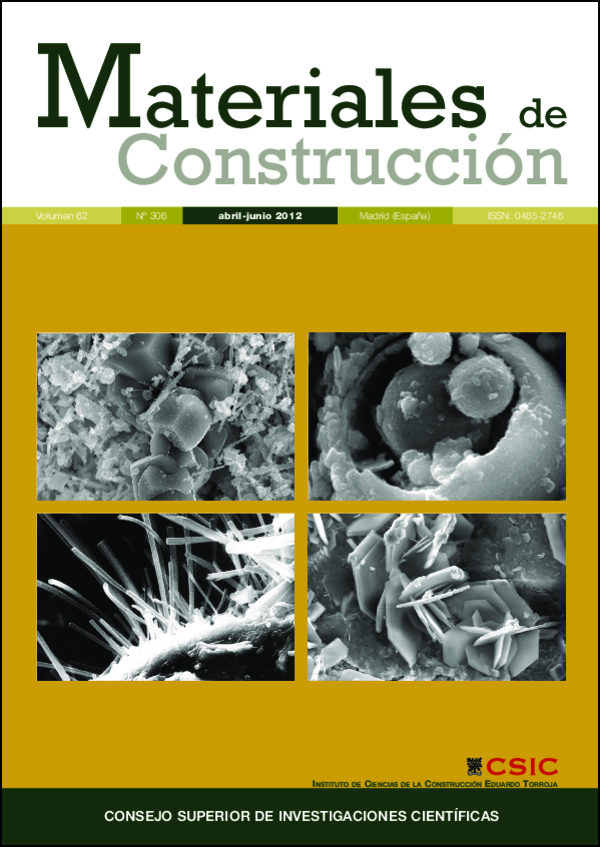Determination of the stress-strain curve in specimens of Scots pine for numerical simulation of defect free beams
DOI:
https://doi.org/10.3989/mc.2012.64110Keywords:
timber construction, numerical simulation, FEM, Pinus sylvestris L.Abstract
The objective of this paper is to develop a twodimensional numerical model to simulate the response of Scots pine (Pinus sylvestris L.) defect free timber members in order to predict the behaviour of these members when subjected to external forces. For this purpose, data of the mechanical properties of Scots pine were obtained by performing experimental tests on specimens. We determined the stresses and deformations of timber beams in the elastic-plastic and plastic phases. In addition, we developed a finite element software that considered the orthotropic nature of timber, the non-linearity of the compression-reduction branch and the differing moduli of elasticity in tension and compression for Scots pine beams free from defects. The software developed simulates an experimental four point bending test according to UNE-EN 408 Standard.
Downloads
References
(1) Argüelles Álvarez, R.; Arriaga Martitegui, F.; Martínez Calleja, J. J.: “Estructuras de madera. Diseño y cálculo”, AITIM, Madrid (2003).
(2) Hermoso Prieto, E.; Fernández-Golfín Seco, J. I.; Díez Barra, M. R.: “Mechanical characterization of timber according to European standards from Spanish provenances of Scots Pine”, Invest. Agrar.: Sist. Recur. For, vol. 12, nº 3 (2003), pp. 103-110.
(3) UNE-EN 408:2004: “Estructuras de madera. Madera aserrada y madera laminada encolada para uso estructural. Determinación de algunas propiedades físicas y mecánicas”. (4) UNE-EN 384:2010. “Madera Estructural. Determinación de los valores característicos de las propiedades mecánicas y la densidad”.
(5) UNE-EN 338:2010. “Madera Estructural. Clases resistentes”.
(6) Fernández-Golfín, J. I.; Díez, M. R.; Hermoso, E.: “Relationships between grade determining properties of Spanish Scots and Laricio Pine structural timber”, Mater. Construcc., vol. 53, nº 270 (2003), pp. 44-45.
(7) Gupta, R.; Heck L. R.; Miller T. H.: “Finite-element analysis of the stress distribution in a torsion test of full-size, structural lumber”, J. Test Eval., vol. 30, nº 4 (2002), pp. 291-302. http://dx.doi.org/10.1520/JTE12319J
(8) Dubois, F.; Chazal, C.; Petit, C.: “Viscoelastic crack growth process in wood timbers: an approach by the finite element method for mode I fracture”, International journal of fracture, vol. 113, nº 4 (2002), pp. 367-388. http://dx.doi.org/10.1023/A:1014203405764
(9) Landis, E. N.; Vasic, S.; Davids, W. G.; Parrod, P.: “Coupled experiments and simulations of microstructural damage in wood”, Experimental Mechanics, vol. 42, nº 4 (2003), pp. 389-394. http://dx.doi.org/10.1007/BF02412143
(10) Landis, E. N.; Fournier, C. R.; Davids, W. G.; Nagy, E.: “Morphological lattice models for the simulation of softwood failure and fracture”, Holzforschung; vol. 61, nº 4 (2007), pp. 360-366. http://dx.doi.org/10.1515/HF.2007.050
(11) Coreau, J. L.; Gustafsson, P.; Persson, K.: “Elastic layer model for application problems in timber engineering”, Wood science and technology, vol. 40, nº 4 (2006), pp. 275-290. http://dx.doi.org/10.1007/s00226-005-0033-x
(12) Ormarsson, S.; Petersson, H.; Erikson, J.: “Finite-element analysis of coupled nonlinear heat and moisture transfer in wood”, Numerical heat transfer par A-Aplications, vol. 50, nº 9 (2006), pp. 851-864.
(13) Daudeville, L.: “Fracture in spruce: experiment and numerical analysis by linear and non-linear fracture”, Holz roh Werkstoff, vol. 57, nº 6 (1999), pp. 425-432. http://dx.doi.org/10.1007/s001070050068
(14) Williams, J. M.; Friedley, K. J.; Cofer, W. F.; Falk, R. H.: “Failure modeling of sawn lumber with a fastener hole”, Finite Element in Analysis and Design, vol. 36, nº 1 (2000), pp. 83-98. http://dx.doi.org/10.1016/S0168-874X(00)00010-X
(15) Chassagne, P.; Bou-Said, E.; Jullien, J. F.; Galimard, P.: “Three dimensional creep model for wood under variable humidity-numerical analyses at different material scales”, Mechanics of time-dependent material, vol. 9, nº 4 (2005), pp. 203-223.
(16) Villar, J. R.; Guaita, M.; Vidal, P.; Arriaga, F.: “Analysis of the stress state at the cogging joint in timber structures”, Biosystem engineering, vol. 96, nº 1 (2007), pp. 79-90.
(17) Villar, J. R.; Guaita, M.; Vidal, P.; Argüelles Bustillo, R.: “Numerical simulation of framed joints in sawn-timber roof structures”, Spanish journal of agricultural research, vol. 6, nº 4 (2008), pp. 508-520.
(18) Köck, B.; Holzel S. M.: “The load-displacement behaviour of halved joints”, Proceedings of World Conference Timber Engineering (2010).
(19) Jasienko, J.; Nowak, T.; Czepizak, D.: “Numerical analysis of CFRP-Reinforced wooden beams under bending”, Proceedings of World Conference Timber Engineering (2010).
(20) UNE 56535:1977: “Características físico-mecánicas de la madera. Determinación de la resistencia a la compresión axial”.
(21) Argüelles Bustillo, R.: “Predicción con simulación animada del comportamiento de piezas de madera”, Tesis Doctoral, Universidad Politécnica de Madrid, Escuela Técnica Superior de Ingenieros de Montes (1994).
Downloads
Published
How to Cite
Issue
Section
License
Copyright (c) 2012 Consejo Superior de Investigaciones Científicas (CSIC)

This work is licensed under a Creative Commons Attribution 4.0 International License.
© CSIC. Manuscripts published in both the printed and online versions of this Journal are the property of Consejo Superior de Investigaciones Científicas, and quoting this source is a requirement for any partial or full reproduction.All contents of this electronic edition, except where otherwise noted, are distributed under a “Creative Commons Attribution 4.0 International” (CC BY 4.0) License. You may read here the basic information and the legal text of the license. The indication of the CC BY 4.0 License must be expressly stated in this way when necessary.
Self-archiving in repositories, personal webpages or similar, of any version other than the published by the Editor, is not allowed.


















